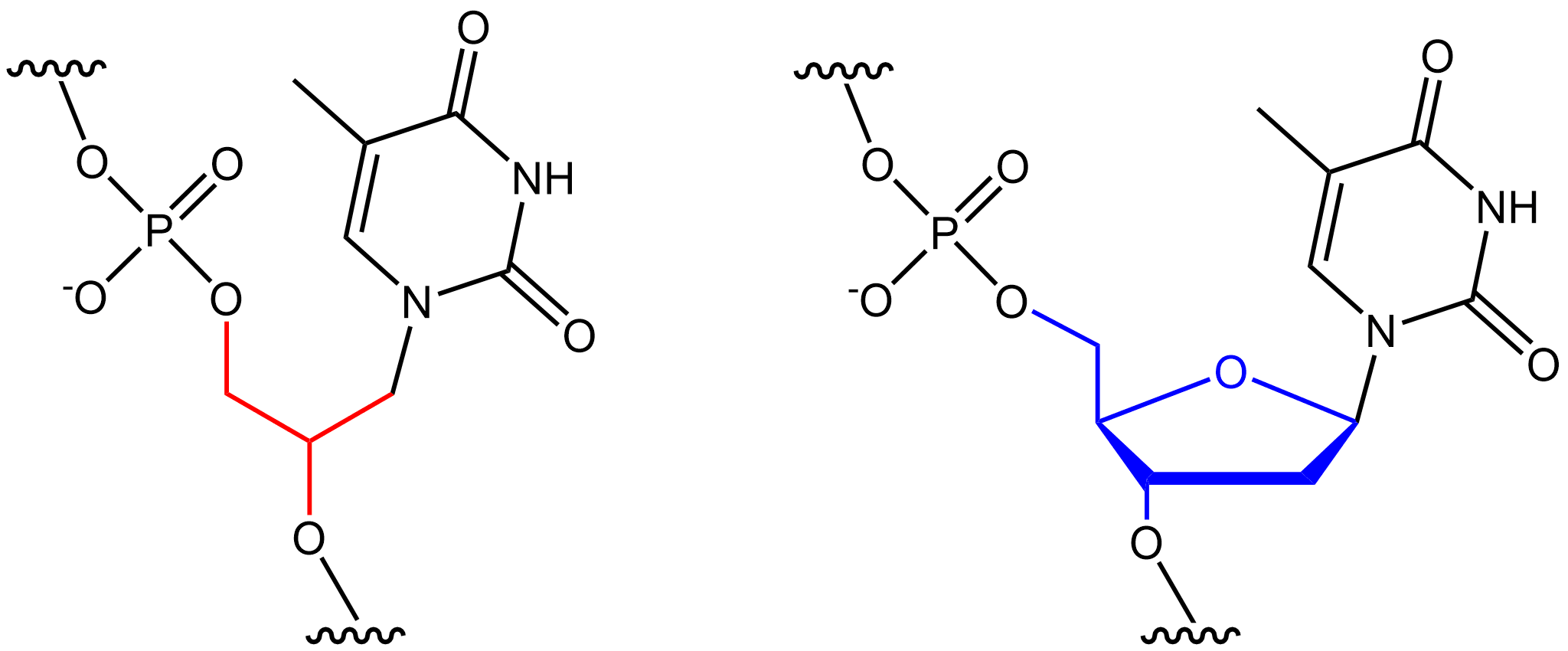Glycol nucleic acid on:
[Wikipedia]
[Google]
[Amazon]
 Glycol nucleic acid (GNA), sometimes also referred to as glycerol nucleic acid, is a nucleic acid similar to DNA or RNA but differing in the composition of its sugar-phosphodiester backbone, using
Glycol nucleic acid (GNA), sometimes also referred to as glycerol nucleic acid, is a nucleic acid similar to DNA or RNA but differing in the composition of its sugar-phosphodiester backbone, using
Simpler than DNA
- Chemical & Engineering News Nucleic acids {{genetics-stub
 Glycol nucleic acid (GNA), sometimes also referred to as glycerol nucleic acid, is a nucleic acid similar to DNA or RNA but differing in the composition of its sugar-phosphodiester backbone, using
Glycol nucleic acid (GNA), sometimes also referred to as glycerol nucleic acid, is a nucleic acid similar to DNA or RNA but differing in the composition of its sugar-phosphodiester backbone, using propylene glycol
Propylene glycol (IUPAC name: propane-1,2-diol) is a viscous, colorless liquid, which is nearly odorless but possesses a faintly sweet taste. Its chemical formula is CH3CH(OH)CH2OH.
Containing two alcohol groups, it is classed as a diol. It i ...
in place of ribose or deoxyribose. GNA is chemically stable but not known to occur naturally. However, due to its simplicity, it might have played a role in the evolution of life.
The 2,3-dihydroxypropyl nucleoside analogues were first prepared by Ueda et al. (1971). Soon thereafter it was shown that phosphate-linked oligomers of the analogues do in fact exhibit hypochromicity in the presence of RNA and DNA in solution (Seita et al. 1972). The preparation of the polymers was later described by Cook et al. (1995, 1999) and Acevedo and Andrews (1996). However the ability of GNA-GNA self-pairing was first reported by Zhang and Meggers in 2005. Crystal structures of a GNA duplexes were subsequently reported by Essen and Meggers.
DNA and RNA have a deoxyribose
Deoxyribose, or more precisely 2-deoxyribose, is a monosaccharide with idealized formula H−(C=O)−(CH2)−(CHOH)3−H. Its name indicates that it is a deoxy sugar, meaning that it is derived from the sugar ribose by loss of a hydroxy group. D ...
and ribose
Ribose is a simple sugar and carbohydrate with molecular formula C5H10O5 and the linear-form composition H−(C=O)−(CHOH)4−H. The naturally-occurring form, , is a component of the ribonucleotides from which RNA is built, and so this compo ...
sugar backbone, respectively, whereas GNA's backbone is composed of repeating glycol units linked by phosphodiester bond
In chemistry, a phosphodiester bond occurs when exactly two of the hydroxyl groups () in phosphoric acid react with hydroxyl groups on other molecules to form two ester bonds. The "bond" involves this linkage . Discussion of phosphodiesters is d ...
s. The glycol unit has just three carbon
Carbon () is a chemical element with the symbol C and atomic number 6. It is nonmetallic and tetravalent—its atom making four electrons available to form covalent chemical bonds. It belongs to group 14 of the periodic table. Carbon mak ...
atoms and still shows Watson-Crick base pairing. The Watson-Crick base pairing is much more stable in GNA than its natural counterparts DNA and RNA as it requires a high temperature to melt a duplex of GNA. It is possibly the simplest of the nucleic acids, making it a hypothetical precursor to RNA.
See also
*Abiogenesis
In biology, abiogenesis (from a- 'not' + Greek bios 'life' + genesis 'origin') or the origin of life is the natural process by which life has arisen from non-living matter, such as simple organic compounds. The prevailing scientific hypothes ...
*Locked nucleic acid
A locked nucleic acid (LNA), also known as bridged nucleic acid (BNA), and often referred to as inaccessible RNA, is a modified RNA nucleotide in which the ribose moiety is modified with an extra bridge connecting the 2' oxygen and 4' carbon. Th ...
*Oligonucleotide synthesis
Oligonucleotide synthesis is the chemical synthesis of relatively short fragments of nucleic acids with defined chemical structure (sequence). The technique is extremely useful in current laboratory practice because it provides a rapid and inexpen ...
*Peptide nucleic acid
Peptide nucleic acid (PNA) is an artificially synthesized polymer similar to DNA or RNA.
Synthetic peptide nucleic acid oligomers have been used in recent years in molecular biology procedures, diagnostic assays, and antisense therapies. Due ...
*Threose nucleic acid Threose nucleic acid (TNA) is an artificial genetic polymer in which the natural five-carbon ribose sugar found in RNA has been replaced by an unnatural four-carbon threose sugar.Schöning, K. U. ''et al.'' Chemical etiology of nucleic acid structu ...
References
Further reading
* * * * * *External links
Simpler than DNA
- Chemical & Engineering News Nucleic acids {{genetics-stub